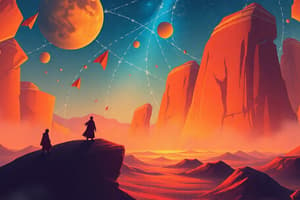Podcast
Questions and Answers
Which of the following is NOT a type of literacy related to media, as discussed in the text?
Which of the following is NOT a type of literacy related to media, as discussed in the text?
- Digital Literacy
- Information Literacy
- Multicultural Literacy
- Emotional Literacy (correct)
What is one of the biggest risks of media consumption mentioned in the text?
What is one of the biggest risks of media consumption mentioned in the text?
- Improved communication skills
- Misinformation and fake news (correct)
- Reduced reliance on traditional media
- Increased physical activity
Which of the following statements accurately describes the relationship between traditional media and new media?
Which of the following statements accurately describes the relationship between traditional media and new media?
- Traditional media and new media have no connection to each other.
- Traditional media and new media co-exist, but digital media is growing faster due to ease of access. (correct)
- Traditional media has completely replaced new media.
- New media has completely replaced traditional media.
What is a key characteristic of the Internet of Things (IoT)?
What is a key characteristic of the Internet of Things (IoT)?
Which of the following is NOT a challenge associated with new media, as mentioned in the text?
Which of the following is NOT a challenge associated with new media, as mentioned in the text?
Which of the following statements describes the relationship between media literacy and understanding how media influences our perceptions?
Which of the following statements describes the relationship between media literacy and understanding how media influences our perceptions?
Which statement best describes the concept of information literacy in relation to media consumption?
Which statement best describes the concept of information literacy in relation to media consumption?
How does the text define media literacy?
How does the text define media literacy?
Which of the following is NOT a communication technology used in IoT?
Which of the following is NOT a communication technology used in IoT?
How do embedded systems improve efficiency in industries?
How do embedded systems improve efficiency in industries?
What is the primary function of cloud computing in the context of IoT?
What is the primary function of cloud computing in the context of IoT?
Which of the following is NOT a benefit of using big data in IoT?
Which of the following is NOT a benefit of using big data in IoT?
Which of these is an example of how embedded systems enhance efficiency in industries?
Which of these is an example of how embedded systems enhance efficiency in industries?
What is the main difference between GPS and RTLS?
What is the main difference between GPS and RTLS?
How does IoT contribute to improving urban infrastructure?
How does IoT contribute to improving urban infrastructure?
Which of the following is a major challenge faced by IoT systems?
Which of the following is a major challenge faced by IoT systems?
Which of these is NOT a key skill needed for working with IoT?
Which of these is NOT a key skill needed for working with IoT?
What is a key benefit of using IoT in healthcare?
What is a key benefit of using IoT in healthcare?
Which of the following is NOT an example of a real-world IoT application?
Which of the following is NOT an example of a real-world IoT application?
What is a key difference between traditional marketing and how IoT can affect marketing strategies?
What is a key difference between traditional marketing and how IoT can affect marketing strategies?
How does IoT contribute to the growth of big data?
How does IoT contribute to the growth of big data?
What is a potential ethical concern related to the use of IoT and personal data?
What is a potential ethical concern related to the use of IoT and personal data?
What role does machine learning and AI play in IoT systems?
What role does machine learning and AI play in IoT systems?
Which of these is NOT a factor driving the evolution of IoT?
Which of these is NOT a factor driving the evolution of IoT?
Flashcards
IoT Devices
IoT Devices
Devices equipped with sensors, actuators, and connectivity for data collection and automation.
Hyper-Personalized Content
Hyper-Personalized Content
Content tailored specifically to individual users' preferences using IoT data.
Smart Fridges
Smart Fridges
Refrigerators that track contents and suggest grocery orders based on usage patterns.
5G Networks
5G Networks
Signup and view all the flashcards
Machine Learning in IoT
Machine Learning in IoT
Signup and view all the flashcards
Smart Homes
Smart Homes
Signup and view all the flashcards
Security Challenges in IoT
Security Challenges in IoT
Signup and view all the flashcards
Networking in IoT
Networking in IoT
Signup and view all the flashcards
Media Literacy
Media Literacy
Signup and view all the flashcards
Digital Literacy
Digital Literacy
Signup and view all the flashcards
Information Literacy
Information Literacy
Signup and view all the flashcards
Traditional Media
Traditional Media
Signup and view all the flashcards
New Media
New Media
Signup and view all the flashcards
Challenges of New Media
Challenges of New Media
Signup and view all the flashcards
Misinformation
Misinformation
Signup and view all the flashcards
Internet of Things (IoT)
Internet of Things (IoT)
Signup and view all the flashcards
Encryption
Encryption
Signup and view all the flashcards
IoT Data
IoT Data
Signup and view all the flashcards
Embedded Systems
Embedded Systems
Signup and view all the flashcards
Cloud Computing
Cloud Computing
Signup and view all the flashcards
Big Data
Big Data
Signup and view all the flashcards
Wireless Communication
Wireless Communication
Signup and view all the flashcards
Predictive Analysis
Predictive Analysis
Signup and view all the flashcards
Security Vulnerabilities
Security Vulnerabilities
Signup and view all the flashcards
Study Notes
Chapter 1: Introduction to New Media Literacy
- New media literacy is the ability to access, analyze, evaluate, and communicate media content, helping individuals critically understand messages.
- Young people spend an average of 6.5 hours daily on media, which includes TV, music, internet, video games, mobile devices, social media, and streaming.
- Despite high media consumption, engagement with physical activities and family time is limited.
- Types of literacy related to media include digital literacy, information literacy, multicultural literacy, and emerging technology literacy.
- Traditional media includes newspapers, TV, radio, and magazines. New media includes social media, blogs, mobile apps, and interactive websites.
- New media is growing faster due to its accessibility.
- Challenges of new media include misinformation, fake news, social isolation (overuse of digital devices reducing real-life interactions), and privacy issues (social media and online platforms collecting personal data raising concerns about surveillance).
Chapter 2: Internet of Things (IoT) – The Future of New Media
- IoT refers to everyday objects embedded with sensors, software, and internet connectivity, enabling devices to collect and exchange data, automating processes without human intervention.
- IoT's impact on new media includes the rise of smart TVs, wearables, and voice assistants, which have changed media consumption and enabled hyper-personalized content.
- Businesses use IoT-generated data to predict consumer behavior, and smart fridges can suggest grocery orders based on usage patterns.
- IoT generates massive amounts of data that businesses analyse to improve services using AI and machine learning.
Chapter 3: Introduction to Internet of Things (IoT)
- IoT devices consist of sensors, actuators, and connectivity modules, sensing the environment, collecting data, and triggering actions automatically, such as a smart thermostat adjusting room temperature.
- Necessary skills for IoT users include hardware development, networking, application development, security, and privacy, and machine learning and AI to analyze real-time IoT data.
- IoT is evolving due to faster internet speeds, AI, and cloud computing, and the adoption of 5G networks.
- Real-world applications of IoT include smart homes (automated lights, smart locks, voice assistants), and healthcare (remote patient monitoring through smart medical devices) and industrial IoT (sensors in factories for predicting machine failure).
Chapter 4: Technologies Behind IoT
- Embedded systems are small computers built into devices, for example, smart thermostats, and automated vehicles.
- IoT hardware includes microcontrollers (like Arduino and Raspberry Pi) and sensors.
- IoT software includes RIOT OS and Thingsquare Mist.
- Communication technologies include Wi-Fi and Bluetooth.
Chapter 5: IoT Connection to Cloud Computing and Big Data
- Cloud platforms store and analyze IoT data in real time.
- Massive data from IoT devices (big data) helps in predictive analysis and automation.
- Real-world examples of IoT and cloud computing interaction include smart homes, and smart cities (e.g., traffic control, energy management).
- Big Data challenges include managing large-scale data, security risks, and system reliability.
- Cloud computing provides essential infrastructure for IoT.
Chapter 6: Introduction to Big Data
- Big data refers to large amounts of structured and unstructured data generated daily.
- Sources of big data include social media, IoT sensors, and business transactions.
- Big data processing models include OLTP, OLAP, and RTAP.
- Big data challenges involve managing, analyzing, and securing large datasets.
- Big data is used for decision making in businesses, and it drives business intelligence and AI development.
Studying That Suits You
Use AI to generate personalized quizzes and flashcards to suit your learning preferences.




